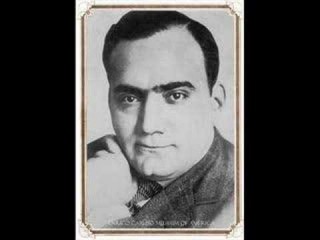
Enrico Caruso biography
Date of birth : 1873-02-25
Date of death : 1921-08-02
Birthplace : Naples, Italy
Nationality : Italian
Category : Famous Figures
Last modified : 2011-04-03
Credited as : Opera Tenor, Metropolitan Opera, Vienna Caruso nights
Enrico Caruso was an Italian tenor who was an early recording artist and the foremost Metropolitan Opera attraction for a generation. For power, sweetness, and versatility his voice was without peer.
Born on Feb. 25, 1873, in Naples, Enrico Caruso was the eighteenth child of a poverty-ridden machinist. Early encouragement came from fellow workers who heard him sing Neapolitan ballads. Guglielmo Vergine, his first teacher, held small hopes for him as a professional, and Caruso's early efforts were not promising. He made his debut in L'Amico Francesco at the Teatro Nuovo, Naples, in 1894, and his apprenticeship was in small Italian theaters singing a variety of roles.
Selected for the tenor lead in the premiere of Umberto Giodano's Fedorain Milan in 1898, Caruso scored an electrifying success. Engagements at St. Petersburg, Moscow, Buenos Aires, and Bologna were climaxed by an invitation to sing at La Scala, the great opera house at Milan, directed by Giulio Gatti-Casazza and Arturo Toscanini. After triumphs with soprano Nellie Melba in La Bohème at Monte Carlo and Rigoletto in London in 1902, Caruso was engaged by the Metropolitan Opera Company. He made his New York debut in Rigoletto in 1903, and was connected with the "Met" for the rest of his life.
Idolized in every operatic center, the flamboyant Neapolitan was the subject of almost unprecedented publicity. In Berlin and Vienna "Caruso nights" were celebrated, and in Mexico City he received $15,000 for a single performance. At the peak of his career, his performance fees exceeded $500,000 annually. The earliest of his nearly 250 recordings dates from 1902, and his annual income from this source alone reached $115,000.
Caruso's liaison (never legalized) with Ada Giachetti, by whom he had two sons, was painfully ended by court proceedings in 1912. In 1918 he married Dorothy Park Benjamin, daughter of a wealthy New York industrialist. Stricken with a throat hemorrhage during a performance at the Brooklyn Academy of Music, Caruso sang only once more—a performance of La Juive at the Met in 1920. He died in Naples on Aug. 2, 1921.
Supremely gifted for opera by temperament and physique, Caruso was also single-minded, hard-working, and self-critical. An awkward actor in the beginning, he developed into a superlative artist. Certain roles, such as Canio in Pagliacci and Radames in Aida, became so indelibly his that all other tenors suffer by comparison. He had a remarkable range, but when the lighter quality of his early years darkened, his voice was less suitable for some of the lyric roles. In power and expressiveness, however, his abilities suffered no impairment despite a temporary loss of voice during the 1908-1909 season.
Among Caruso's many honors were commendatore in the Order of the Crown of Italy, the French Legion of Honor, and the Order of the Crown Eagle of Prussia. He was totally free from professional jealousies. A natural comedian, he was also a gifted caricaturist. His warmhearted generosity made him genuinely loved by his associates and the public at large to a degree almost unique in the lyric theater.
Enrico Caruso, His Life and Death (1945) is a beautifully written tribute by his wife, Dorothy Park Caruso. Pierre V. R. Key and Bruno Zirato, Enrico Caruso, a Biography (1922), lacks objectivity. T. R. Ybarra, Caruso: The Man of Naples and the Voice of Gold (1953), is packed with vivid reminiscences. More specialized works are Enrico Caruso, Caricatures (1906; new ed. 1914), and Aida Favia-Artay, Caruso on Records (1965). Other valuable sources are Frances Alda, Men, Women, and Tenors (1937); Giulio Gatti-Casazza, Memories of the Opera (1941); and Henry Pleasants, The Great Singers: From the Dawn of Opera to Our Own Time (1966).
















